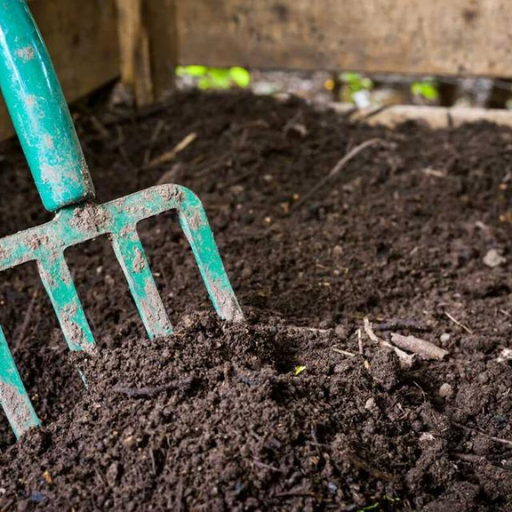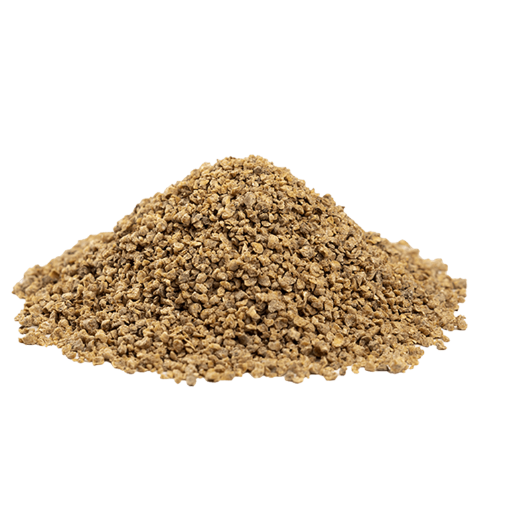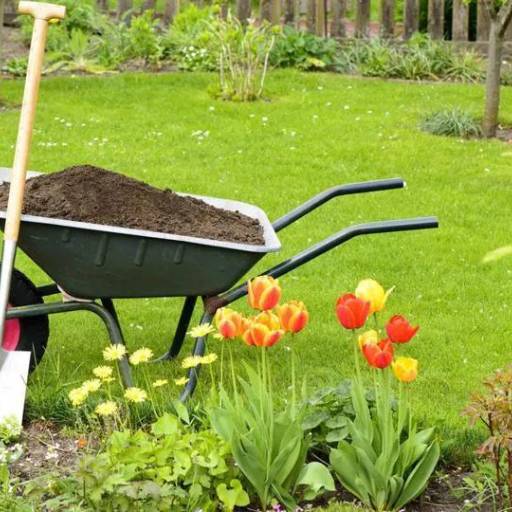Maintaining a lush, green lawn doesn’t have to come at the expense of the environment. As awareness of sustainable practices grows, more homeowners are turning to natural organic lawn fertilizers for nurturing their gardens. This blog aims to guide you through the benefits and best practices of using organic fertilizers, ensuring that your lawn remains healthy and vibrant all year round. From understanding the composition of these eco-friendly products to learning about their application and impact, we’ll cover everything you need to know to cultivate a thriving, natural lawn. So, let’s dive into the world of sustainable lawn care and discover how you can make greener choices for a better future.
What is Organic Lawn Fertilizer?

Organic fertilizer ingredients for the care of lawns
Natural materials from plants, animals or minerals make up organic lawn fertilizers. Some common components include fish emulsion, compost, seaweed, manure, bone meal and blood meal. These ingredients act together to provide important nutrients such as nitrogen, phosphorus and potassium necessary for healthy growth of plants. Organic alternatives to synthetic fertilizers release their nutrients gradually as a result improving soil structure and encouraging microbial activity which means that they are more sustainable in the long run.
Why Choose Organic Fertilizer Rather Than Synthetic Fertilizers?
There are several advantages of using an organic fertilizer over artificial ones. First and foremost is that organic fertilizers are ecofriendly; they don’t have harmful chemicals that can percolate into water supplies resulting in pollution and damage of aquatic ecosystems. Secondly, organic fertilizers enhance soil health by improving soil structure thereby increasing biodiversity. They introduce beneficial microorganisms involved in nutrient cycling hence leading to a healthier grass that is resilient against disease. Finally, organic fertilizers provide a slow steady release of nutrients closer to the natural pace at which plants grow reducing risks from overfertilization and making sure there is enough food available to the lawn over a longer period promoting sustained growth hence reducing times when you need to feed your grass with it.
How to Apply Organic Lawn Fertilizer?
Best Time to Apply Organic Lawn Fertilizer
It is during the springs and falls growing season when organic lawn fertilizer should be applied, because it is only at this time that it will serve its purpose most effectively. During springtime, when soil temperatures rise, applying organic fertilizer can help support new growth as well as strengthen the lawn once winter dormancy has subsided. The same applies to fall application since it readies the grass for colder months, thereby enhancing root development and increasing overall turf resilience. To achieve best outcomes, spread fertilizer early in these seasons allowing adequate absorption and utilization of nutrients by the lawns. Avoid application during extreme heat or when the lawn is dormant as a result of nutrient wastage and potential stress on the lawn.
Using a Spreader for Even Application
Using a spreader guarantees consistent distribution of organic lawn fertilizer over your entire yard thus fostering uniform growth and preventing cases of localized nutrient deficiency. For best results:
- Select the Right Spreader: The two main types are broadcast (rotary) spreader drop spreaders. Broadcast spreads cover larger areas more quickly while drop spreads provide better control over where product lands.
- Calibrate Your Spreader: Before you apply your chosen organic fertilizer refer to manufacturers guidelines to know how much flow rate would be sufficient for your preferred type of fertilizer. This ensures that the right amount of manure is released per unit area.
- Fill Spreader on Hard Surface: Filling a spreader on a driveway or path prevents spillage which could cause unevenness in application.
- Walk at a Steady Pace: As you proceed across your garden ensure that you walk with an even speed so as each part gets fertilized equally all through without streaks being left behind.
- Follow a Pattern: Start by going one way then crisscrossing back; also known as applying crosswise pattern from edge-to-edge after full coverage has been achieved in one direction reduces chances of missing some parts and ensure uniformness of fertilization.
In this way, you can effectively employ a spreader to administer organic lawn fertilizer on your turf such that the nutrients it requires are fairly and effectively distributed.
Calculating the Correct N-P-K Ratio
N-P-K ratio is an indicator of the percent composition of nitrogen (N), phosphorus (P) and potassium (K) in a given manure. To calculate the right N-P-K ratio for your garden, use these steps:
- Do a Soil Test: Take a soil sample and send it to laboratory for analysis, which will reveal any deficiencies existing.
- Identify Lawn Requirements: The grass type, soil type and climate determine what different lawns need in terms of nutrients. In general, nitrogen encourages vigorous growth with green color; phosphorous supports root development while potassium promotes drought resistance and disease resistance.
- Choose an Appropriate Fertilizer: Select a fertilizer that matches nutrient requirements indicated by your soil test. For example 3-1-2 is often recommended as overall maintenance ratio but your soil test may suggest another mix containing other proportions.
- Follow Application Guidelines: The application rates and schedules listed on fertilizer package should be followed but adjusted accordingly based on results from specific needs identified in your soil test to avoid over or under fertilizing.
Through understanding the soil status and lawn’s precise nutritional requirements, calculating and finally applying correct N-P-K ratio will enhance proper lawn care practices for healthier growth.
What Nutrients are Essential for a Healthy Lawn?

Significance of Nitrogen, Phosphorus, and Potassium
- Nitrogen (N): Significant for grass growth and green coloration. It promotes leaf growth and helps to maintain a dense lawn. Sufficient nitrogen levels aid in the formation of chlorophyll, which is needed for photosynthesis. Yellowing and dwarfing may result from nitrogen deficiency.
- Phosphorus (P): Important to encourage good root systems that enable food movement inside plants. This nutrient is mainly important during the initial stages of grass growing when new lawns are established using seed or sod. It also supports flowering and seed production that aids in lawn recovery or thickening.
- Potassium (K): These nutrients ensure resistance of the turf to stresses like disease, drought, cold weather etc. Water uptake, enzyme activation and photosynthesis are some of the physiological functions facilitated by potassium on your lawn. Moreover, potassium improves overall hardiness or durability of a turf enabling it to be resilient under harsh conditions.
By understanding these primary nutrients through proper fertilizing practices one achieves healthier lawns with more vigor which can resist environmental challenges better
Understanding Organic Matter’s Role In Lawn Care
Organic matter greatly improves soil structure and fertility thus playing a vital role in lawn care. Incorporating organic matter such as composts; grass clippings or decomposed leaves enhances soil aeration as well as water holding capacity hence improving overall soil health. Such enrichments provide essential nutrition to the soil along with beneficial microorganisms that stimulate root growth and promote development of healthy turf areas within gardens. Additionally, organic matter can help cycle nutrients slowly over time where grass will be provided with constant supply hence making it sustainable method towards a vigorous long-lasting environment friendly yard.
What Are the Different Types of Organic Lawn Fertilizers?

Granular and Liquid Organic Fertilizers
To find out the best choice between granular and liquid organic fertilizers, there are many things you should take into considerations.
Granular Organic Fertilizers: These fertilizers exist as solids that can either be spread manually or by a spreader. They are nutrients that break down slowly in the soil over a long period of time. This reduces the possibility of nutrient leaching and ensures constant supply of nutrients to the lawn. Granular fertilizers are good for people who want long-term goals with fewer applications. However, they must be watered in via irrigation or rainfall for nutrient release to commence.
Liquid Organic Fertilizers: Concentrated liquids that need dilution or ready-to-use formulations applied with a sprayer constitute these kinds of organic fertilizers. Those ones which are used quickly provide fast acting nutrients because they become available to the plants right after their application. Quick nutrient boost is what liquid fertilizers are important to achieve or correct specific deficiencies in plant nutrition but excessive applications may result in high risk of nutrient washout due to their quick-release properties.
The choice between granules and liquids depends on your lawn care objectives, immediate results versus long-term maintenance, personal preferences etc most importantly, goals for how often you plan on applying fertilizer and how much effort you’re willing to put into it. Therefore, while granules offer convenience and continued nourishing effect liquid types provide fast-acting solutions for instant mineral uptake.
Advantages of Slow-Release Fertilizers
For both plants and environment slow-release fertilisers have several benefits. Firstly, it helps maintain an extended steady supply of all needed elements making them available when required during plant growth duration. Such consistent release gives rise to healthy development processes which will prevent deficiency issues from taking place/ Secondly, slow-release nitrogenous fertilizer has a reduced rate at which its contents are dissolved hence a lesser chance of dissolving nutrients into the ground water making it ecofriendly. Besides, less often usage is needed because of this slow release rate thus saving time and labor. Other than that, the risk of fertilizer burn is reduced by slow-release nitrogenous fertilizers. That means when too much nutrients are supplied to plants at once, this can lead to fertilizer burn. In summary, these gains make this form of fertilization technique ideal in sustaining beautiful and healthy lawn.
How to Care for Your Lawn After Fertilization?

Watering Your Lawn Post-Fertilization
After adding fertilizer to your lawn, it is important that you water it. In most cases, immediately after application of the manure on my grass is when I do watering because this helps dissolve mineral nutrients and make them go deep into the soil. This can be a better way for the fertilizer to reach straight to the grassroots. Depending on the kind of fertilizer one uses, the amount of water may also vary, but often light or moderate sprinkling is enough. Moreover, in the morning is when I water since during day time all moisture goes away leaving no chances for diseases. A regular supply of water makes the turf healthy and vigorous by encouraging stronger root formation and limiting escape of nutrients.
The Best Way To Mow
It’s vital that you mow your lawn properly so as to keep its health status as well as appearance intact. To be sure about its height I usually mow it at approximately 2.5 to 3 inches which works well with most species of turf grasses. This ensures that there are deep-lying roots and proper shading of grass thus preventing weed growth during summer seasons. Another tip involves cutting blades with sharp edges that make clean cuts thereby reducing tearing and decreasing risk factors for infection occurrence in plants as a result. Besides, I avoid cutting more than one-third blade length in each mowing so as not to strain lawn surfaces under injury symptoms caused by such an action at this tender stage. Also, I always pay attention to how fast my grass grows; therefore, once a week is acceptable frequency for trimming throughout vegetation period while sometimes altering my approach is necessary since I need softer ground consistent bushiness.
Natural Pest And Weed Management
I have several ways through which I manage pests and weeds in my garden naturally. For pest control measures such as birds or beneficial insects creation around; some flowers and shrubs can serve this purpose if they are grown along fences or other places where these organisms frequent gardens. On the other hand, homemade insecticides using garlic, neem oil, or soap are more preferred than the chemical sprays obtained in stores. However, if one has a dense and healthy lawn, there will not be any need of weed management. What I do is to physically remove any growing grasses and mulch around flower beds as it prevents growth of weeds. Additionally, I practice crop rotation and companion planting in my garden to naturally prevent pests and weeds from taking hold. With these natural methods you’ll be able to maintain a lush garden without applying toxic chemicals.
Frequently Asked Questions (FAQs)

Q: How much manure should I apply on my lawn?
A: The amount of manure application will depend on different lawn requirements and kind of organic lawn food. For example, certain natural lawn foods may be locally advised to be applied at particular quantities per square feet of the grass. This is to avoid over-fertilization with fertilizers by reading and following the instructions indicated on them.
Q: Is it safe for me to use organic lawn food around pets and children?
A: Yes, in general, organic lawn food is safe for usage near animals and kids as it is made from natural components that are purely organic. Unlike synthetic fertilizers, these types do not possess similar health risks plus they contribute to a safer environment for lawns.
Q: How often should I feed my natural grass with fertilizer?
A: Most applications of natural grass fertilizer vary depending on specific product type and your turf goals. Commonly, you can make use of the natural lawn feed once per season. However, other brands require regular applications to keep up healthy soil and high quality type of grasses.
Q: What are the benefits of using starter fertilizer for new grass seed?
A: Starter fertilizers provide necessary nutrients needed during seedling establishment allowing young grass seedlings to develop a strong root system easily. Proper root development facilitated by using starter fertilizers leads to improved overall health as well as increased resistance in turfs. These products usually contain elevated phosphorous levels which are fundamental for root growth.
Q: What happens when it rains after applying Nature’s Best fertilizer?
A: Rain can have big impact when using natural fertilizers. It is important therefore that you time your application right; applying ahead of expected rains would help ensure nutrients go into ground rather than being washed away down slopes by rainwater runoff. Water received from rains also assists in breaking down this type of manure into soil elements.
Q: What if my yard has excessive thatch?
A: You could control thatch build up using natural lawn care methods like aerating the soil to enhance soil health as well as organic fertilizers that promote the decomposition of organic matter. Consistent top dressing with organic materials will help prevent thatching from happening and thus improve overall lawn condition.






